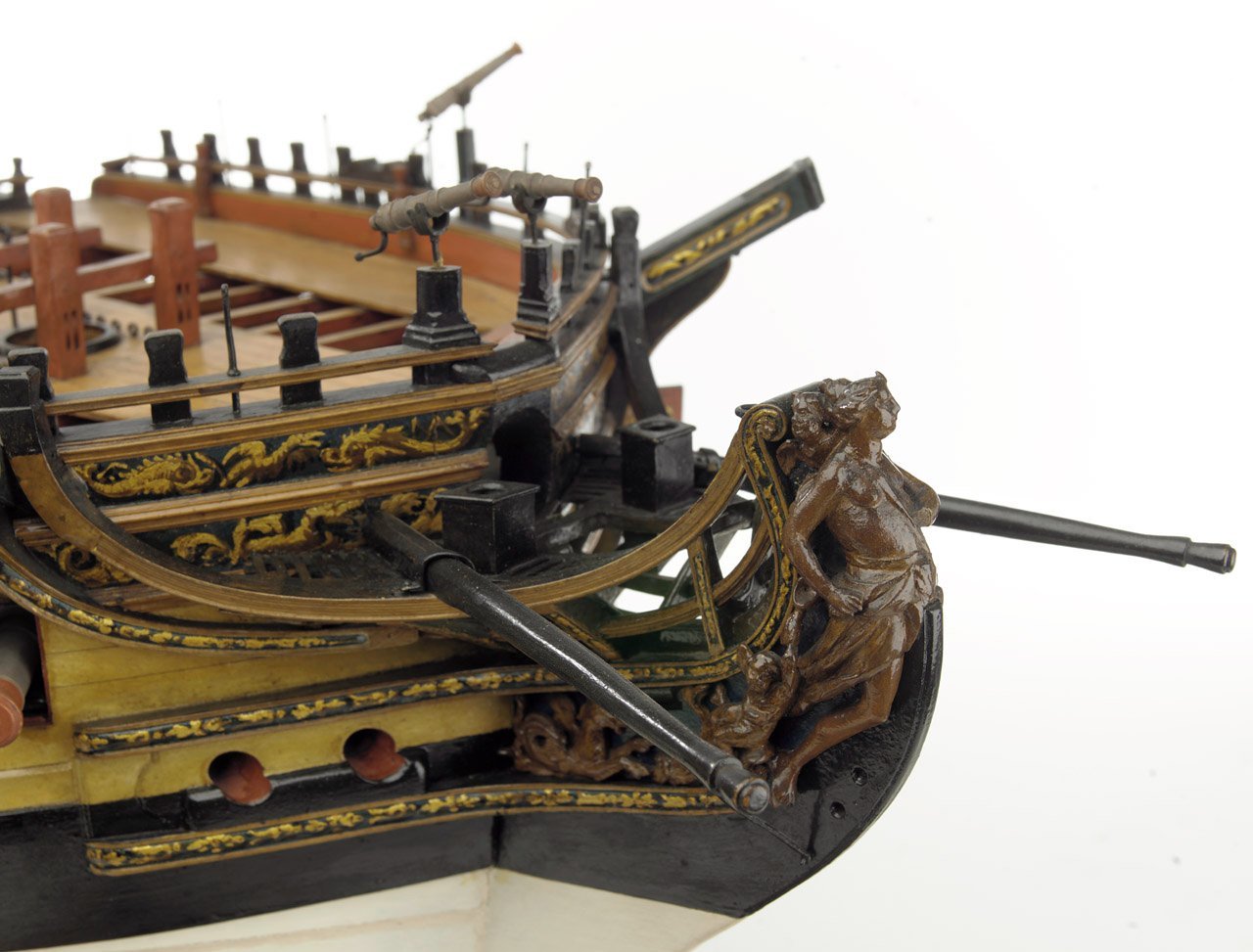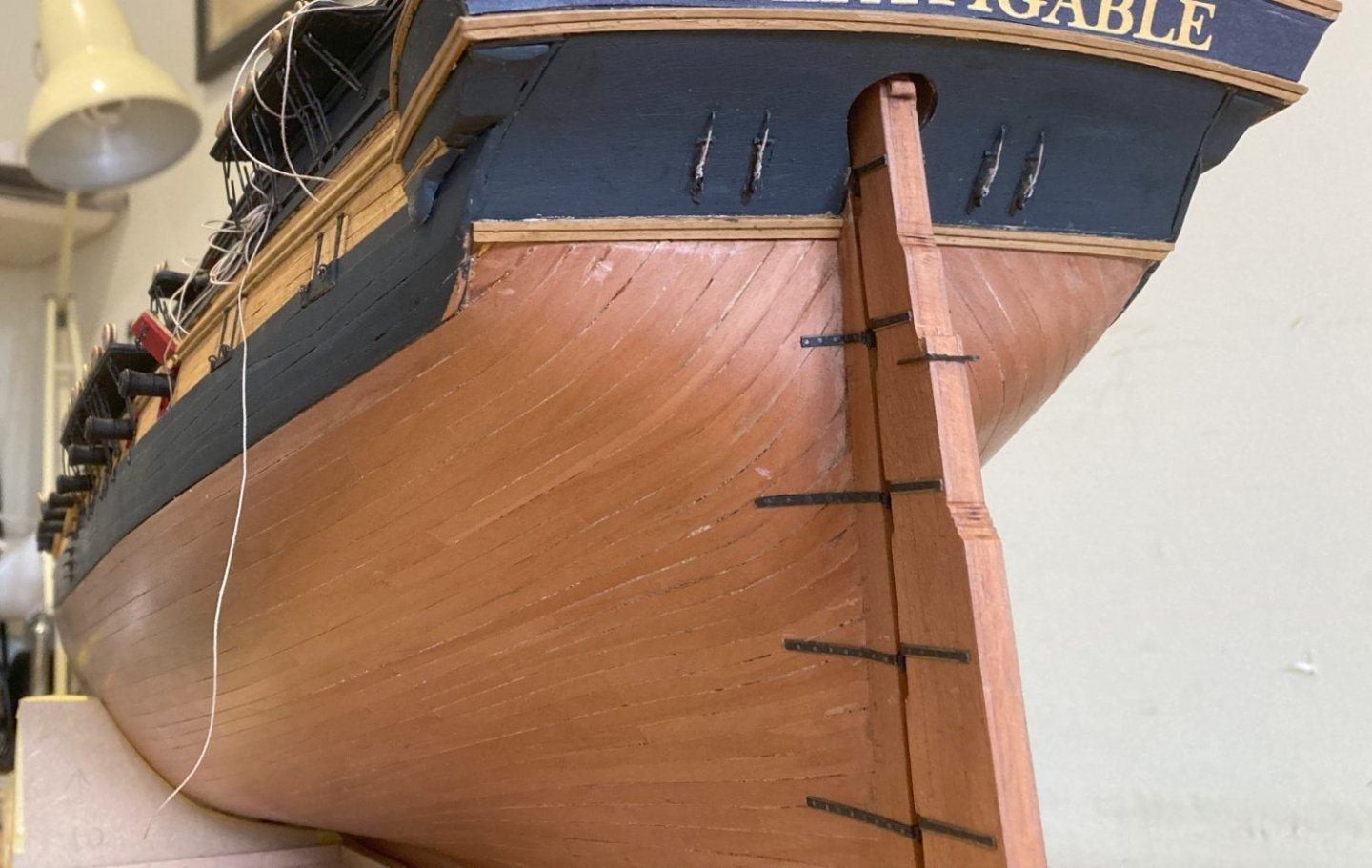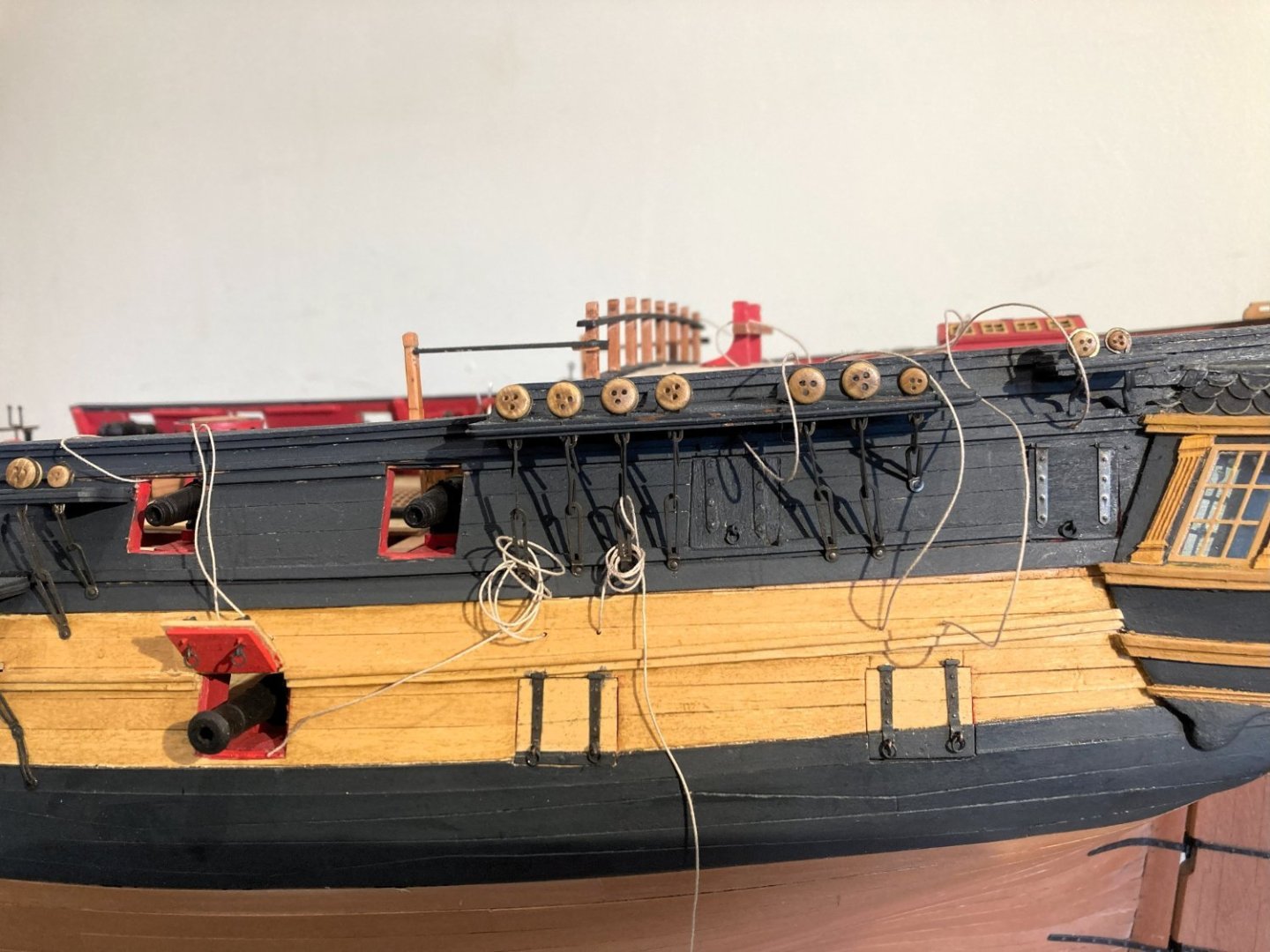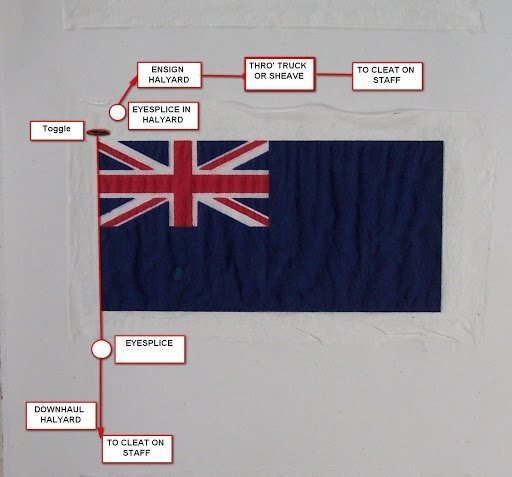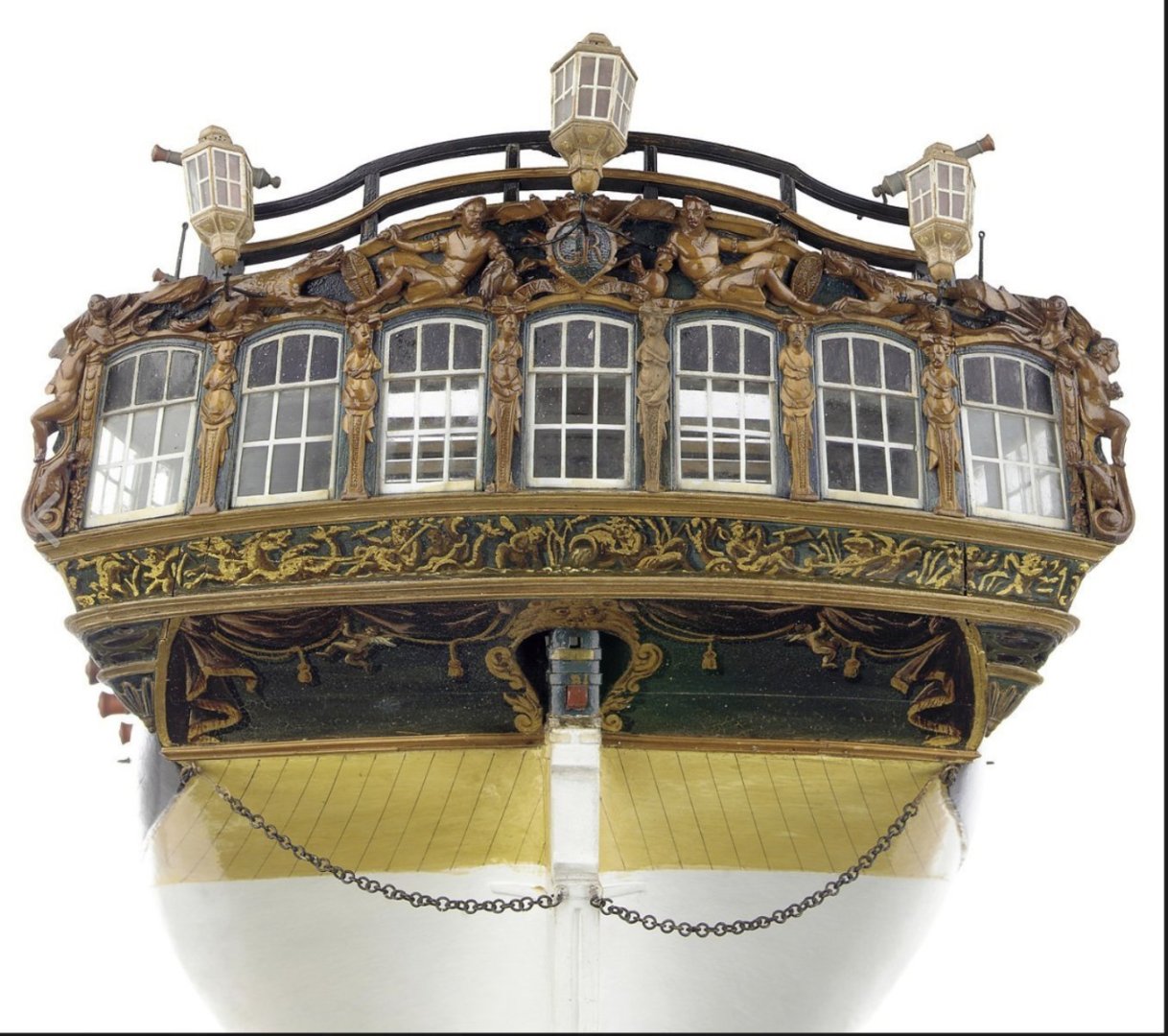-
Posts
4,566 -
Joined
-
Last visited
Content Type
Profiles
Forums
Gallery
Events
Everything posted by Blue Ensign
-
Thankyou Guys for your comments and 'likes' @ Alistair - that shelf is going to need some heavy duty brackets.😉 B.E.
- 648 replies
-
- Indefatigable
- Vanguard Models
-
(and 1 more)
Tagged with:
-
Thank you Walter and Nipper. @ Nipper - I used Syren 0.3mmø line which equates to 2½” circ. (Lavery comments that in the 1780’s port ropes were usually of 3” rope.) Cheers, B.E.
- 648 replies
-
- Indefatigable
- Vanguard Models
-
(and 1 more)
Tagged with:
-
Post One Hundred and Fifty-three Anniversary Today marks twelve months since I started this log. I have worked several hours, mostly each day, over the period and have included many modifications to the basic kit, some obvious, some not so, and some now hidden. That such a large and detailed model can be constructed to this stage in such a relatively short time is all down to Chris’s planning and design and the quality of the fittings. Apart from a few minor additions, the hull is effectively completed. To mark the occasion, I cleaned up my workbench, and took some photo’s using my tripod rather than the usual handheld w-i-p shots. 3854 3899 3900 3901 3898 3863 3886 3876 3878 3889 3897 3895 3896 In the earlier stages of the build, I didn’t have the same sense of enjoyment I had with Sphinx, perhaps because it is a more difficult model to manoeuvre during building, it is large financial investment you don’t want to mess up, and it is a far testier challenge than Sphinx. More recently, with the build challenges mostly behind me, I have warmed to the task, and there’s no denying the ‘Indy’ model certainly has that WOW factor. Mrs W loves it, even if she is still asking where I’m going to put it.🫤 3905 Getting there Gov’nor, getting there. Cheers Gromit. B.E. 05/03/2024
- 648 replies
-
- Indefatigable
- Vanguard Models
-
(and 1 more)
Tagged with:
-
Post One Hundred and Fifty-two Anchors As a change of scene, I thought I would make up a couple of the anchors. The kit includes the four main bower anchors, if the smaller stream and kedge anchors are required they are easily obtained using aftermarket suppliers. The kit provided anchors have a scale shank length of 77mm (16’ 2”) which equates to a weight of 43cwt This weight falls between the allocated anchor weights for 38-50-gun ships. The outer diameter of the ring is 29” which scales to 11.5mm. The thickness of the ring scales to 1.4mm. A 64-gun ship had 4 bowers at 57cwt plus stream at 15cwt and a kedge of 7cwt 2qrts. The kit anchors are 3d printed and very finely sculpted. All the subtle features are moulded into the shank and arms. I think the day of the white metal anchor is coming to a close. As with all resin stuff the parts need washing and priming. The stocks are pre-cut from Pearwood and are faced with a thinner veneer that contains the Trenails correctly positioned and with engraved markings for the iron retaining bands. 3831 The only modification I felt necessary was to taper the arms thickness a little from outside the central area towards the outer ends. This reflects a more authentic shape. Once primed, I used Vallejo black/grey, followed by dark brown /rust weathering powders. 3824 The anchors on the left have had the weathering treatment, those on the right as painted. 3830 Brass wire of 1.4mm ø was used to make the rings which have an outside ø of 11.5mm. 3835 The ends of the rings were reduced in size to fit the shank and chemically blackened to give a little tooth for the puddening. The stock halves have mortises cut into the inner sides to fit against the shank. There should be a gap between them but I thought it a tad too large so I deepened the mortice somewhat. Glued together the facings are then added. 3834 Those familiar with my stuff know that I favour heat shrink rubber tubing to represent iron hoops. The final part is to add the puddening to the anchor ring. I used Syren 0.45mm ø and Morope 0.1mm stuff for the seizings. 3838 In applying the puddening unless you glue the ring in place it needs to be held steady. As I work around the ring I apply pva to help keep it in place. 3842 3847 3849 Capt. Pellew is dwarfed by Indy’s anchors. I won’t be fitting or rigging the anchors but as far as I can see there is no reference to this in either manual or plans, so other sources will have to be found; fortunately there are many available. B.E. 02/03/2024
- 648 replies
-
- Indefatigable
- Vanguard Models
-
(and 1 more)
Tagged with:
-
Neat work on the Mizen Stay Glenn, You know you can improve the look of the mouses on the stay collars immensely simply by using formed styrene tubing or wooden dowel covered with material from a pair of your wife's old tights, but don't let her catch you cutting them up.😉 B.E.
- 587 replies
-
- Indefatigable
- Vanguard Models
-
(and 1 more)
Tagged with:
-
Post One Hundred and fifty-one All things brass A few days taken up with the fitting of deck eyebolts, stanchions, and hammock cranes. 3810 These items are beautifully crafted by Chris particularly the waist cranes with integral retaining hooks and eyes. Cranes also line the Qtr deck bulwark and are placed atop the Qtr deck breast rail. Before removal from the fret I clean with fine steel wool which aids the subsequent blackening process. 3813 Once removed the Qtr deck cranes needed careful cleaning up to remove all traces of the fret nubs and are then trial fitted to reduce handling later. They are given an acid bath, followed by the blackening procedure. 3818 3819 3814 I use 0.5mm ø brass tubing to maintain the line whilst progressively fitting the waist cranes. 3815 3816 3817 3823 I did notice that cranes or stanchions are not provided for the Fo’csle rails between the timberheads. Should there be, I don’t know. 🤔 Victory was equipped with cranes, and the Sphinx model has stanchions around the Fo’csle. The contemporary model of Amazon (32) 1773 had stanchions around the Fo’csle between the timberheads. I am inclined to think that 'Indy' may have had them for safety on the exposed Foc’sle, particularly as we know these razees were prone greater rolling. I’ll have a ferret thro’ my spares box and see how they look. B.E. 29/02/2024
- 648 replies
-
- Indefatigable
- Vanguard Models
-
(and 1 more)
Tagged with:
-
I am impressed by your build Kurt, more so by the difficulties of creating a 1:96 scale build out of a solid hull. That it is your first venture into wooden ship modelling make it even more so. You have produced a fine model of which you should be justly proud. Well done.👏 B.E.
- 112 replies
-
- Bluejacket Shipcrafters
- Constitution
-
(and 2 more)
Tagged with:
-
Thank you, Daniel, hope things are good with you. I have not seen any contemporary information regarding the lead of the pendant and I don’t know whether the knot is a modern convention simply to secure the line, or if a further line was eye spliced to the knot, and set up with a tackle. The arrangement on that wonderful Victory model would seem to fulfil most model making requirements. Harland (Seamanship in the age of Sail) covers various mishaps to wheel and rudder and courses of action to counter them. He mentions the pendants in relation to the loss of the rudder head and use for steering. He shows a tackle secured to a beam athwartships, and a jury rig to the wheel on a Frigate. Re: the leather tubes for the lid lanyards; I did the same as you for the stern ports, but for broadside ports, I am thinking of using the sleeves from telephone wire – if I can remember where I have put my supply.🤔 Regards, B.E.
- 648 replies
-
- Indefatigable
- Vanguard Models
-
(and 1 more)
Tagged with:
-
Post One Hundred and fifty Completing the ports The two enclosed Qtr deck ports remained to be done. Usual top hinged lids into the Great cabin, and a pair of side opening doors into the Coach and Bed space. 3660 I thought I had done with queries about ports, but I’m not entirely convinced why side opening doors are shown in the position they are, constrained by Mizen chains which only allow them to open half way. They are a feature usually found in positions above the channels, or at the foremost bow port, where space is restricted. 2231 This shot onboard Victory taken when I blagged my way onto the Poop deck shows similar doors in place. The photo also has other interesting features. Note the tube thro’ which the port lid lanyard goes inboard, and that the port only has one lanyard presumably due it being of lightweight construction over a Qtr deck cabin. The final interesting feature for detail fans is the knot secured on the Mizen channel. This is the reason at the time I wanted to look over the Poop. The knot secures the Rudder pendant which attaches to the chains and is used to control the rudder should the tiller lines be shot away. Back to INDY.. Notwithstanding the above, the side doors do make a nice feature and provide additional interest to the build, more so if displayed closed. 1901a I used a normal port lid as it makes more sense to me. Stern Ports There are two stern ports engraved on the lower counter, the plans show use of provided hinges (PE47) over the patterns, but I didn’t seem to have sufficient to do this, but the Laser board Syren straps filled in nicely. 3794 This is not a very prominent area of the model but that is no reason not to enhance it. 3796 Addition of double lift rings and lanyards complete the effect. 3800 The trickiest part is securing the lanyards thro’ the lifting rings using a false splice. 3799 Getting the needle thro’ the 0.3mm line is a severe test of my aging eyesight. 1900a Still lot to do on this build. B.E. 26/02/2024
- 648 replies
-
- Indefatigable
- Vanguard Models
-
(and 1 more)
Tagged with:
-
Chuck produces a lot of stuff useful to non Syren kits builders, and I see he now has working port lid hinges (Winchelsea) which may adapt to smaller scales. His Laser board rudder /pintle sets are my go to for use on the Vanguard kits I have built recently, and easily double for lid hinges. For 'Indy' Chris has supplied laser board straps for the Rudder, for me, brass etched rudder straps are a thing of the past. B.E.
- 648 replies
-
- Indefatigable
- Vanguard Models
-
(and 1 more)
Tagged with:
-
Very nicely done Walter, excellent progress. 👍 B.E.
- 95 replies
-
- flirt
- vanguard models
-
(and 1 more)
Tagged with:
-
Nice progress Andrew, and that subtle weathering of the lower hull has worked a treat.👍 Not too sure about those belay pins tho' ! Regards, B.E.
-
Thank you Ron, and Allan for your input. 3787 Chris has done a great job on designing and producing the strops/chain link combinations to allow the fitting of these with the minimum of fuss, and with an excellent result. 3789 The trade-off is that the middle link chains of necessity have a tiny gap that is necessary for linking the strops to the lower chains and is a simplification much appreciated. The middle links should retain that elongated oval shape and personally I don’t think they are improved by either turning them into effectively an iron strap with eyes either end, or trying to squeeze the gap together that risks deforming that perfect oval shape. David Antcherl does indeed cover the making of chains from scratch very well, but in this case, and at this scale, even my inner pedant recognises that rejigging the chains is simply not worth the effort of messing with Chris’s excellent set-up. B.E.
- 648 replies
-
- Indefatigable
- Vanguard Models
-
(and 1 more)
Tagged with:
-
Post One Hundred and forty-nine Thinking more about Gunport lid fittings Before I start the gunport fixing on the Starboard side, my mind keeps returning to those single lanyard fittings. The provided port lids look pretty enough and the brass etch versions provide an easy fixing to the hull with the combined hinge, port stop and flexible tangs for fixing the lid to the hull in the open position. However, I do like to make changes to enhance historical accuracy where I can, and I think Indy should really have double lanyards. On a model the size of Indy, particularly Navy board style, such detail gains more prominence, not having all the top hamper to distract the eye. 3763 Revision One I have mocked up a revised port using a spare port lid. I am using Syren laser board rudder straps, cut to size to act as the hinge straps. These conveniently have nail holes pre-drilled, the bottom one is drilled thro’ to take the ring bolts for the lanyards. The tricky part is representing the port hooks that secure the hinge. For the purposes of my exercise, I have used separate tiny segments of Boxwood. The final touch is to add spots of pva to represent the bolt heads. This would work for closed ports but for open ports wire would need to be inserted in the top edge to replace the tangs on the kit version. Revision Two I had abandoned an early attempt to drill thro’ the bottom bolt head of the kit hinge due to broken bits. I resolved to try again. I filed the bolt head flat and started the hole with an awl. This time I was able to drill thro’ using a 0.6mm drill in a pin vise without breaking the bit. 3772 I secured the hinge to my mini anvil using double sided tape. The ideal solution would be if the hinges could be pre-drilled during manufacture. 3780 Modified hinge straps on the Fore port. The example above it is the laser board version. 3781 The forward of the three port lids will be displayed open. 3782 So, the starboard side ports are fitted with correct double lanyard fixings, and the Port side for a central single lanyard. 3748 Perversely, I think the single lanyard arrangement has a better aesthetic. One last thought on gunport lids: The second and third ports from the bow, adjacent to the Galley, are without lids. These ports lie beneath the Fore Channels. 3784 This is a tricky area, some contemporary models have them some don’t. Logical thinking would support the fitting of lids for those adjacent to the Galley Stove. One big wave and out goes the stove fire that the cook has spent some time getting up to heat, but I don't think they lit the stove in very severe weather.. I note that Alex M’s drawings for his Anson razee do include lids in this area, and incidentally double lid lanyards. The fitting of port lids in the open waist and Qtr deck areas was removed by Navy Board order dating from 1703. Well, that little excursion has soaked up a day and a half, ...........time to move on.🙄 B.E. 24/02/2024
- 648 replies
-
- Indefatigable
- Vanguard Models
-
(and 1 more)
Tagged with:
-
Kit provided hoops at 1:64 scale are probably not feasible, but that doesn't mean they can't be added at that scale. I use sub 1mm strips cut from a Manilla folder which fulfil the purpose very well. They stick easily to the mast, conform to the shape around the cheeks and fish, and are the right colour. B.E.
- 587 replies
-
- Indefatigable
- Vanguard Models
-
(and 1 more)
Tagged with:
-
Post One Hundred and forty-eight Fitting the Main ordnance The design of the 24 pounder carriages is such that it allows the guns to be fitted much later in the build, to reduce the risk of knocking them out of position. The carriages were pinned to the deck earlier, and the guns are slid thro’ the ports to locate the trunnions in the open cap squares. Quite a snug fit and it helps to have the port line at eye level to do the job. 3731 For fixing I used ca on the trunnions and bent nosed tweezers to press them into position. For the eight waist guns, with each fitting the model is rotated to check that the barrels are squarely located on the carriages. For closed decks this aspect won’t be seen. The simplification of the ‘open’ capsquares has no relevance because any view of them is severely limited, and the tops of the trunnions will masquerade as the capsquare tops. Port Lids These are pre-cut in Pearwood and supplied with etch hinges. For the Qtr deck and Bow port lids a sheet of corrected lid patterns is supplied to replace those elements included on the main laser sheet of lids. All these lids are port specific. As with the channel chains, the hinges are chemically blackened. 3737 I re-made the lids for the Main deck ports as I wanted a match to the existing hull planking in Boxwood. I had a fancy to show at least one port closed. 3736 I decided to torment myself with trying to get the aftermost port lid sitting flush and lined up with the wale. 3739 It did take a bit of fettlin’ to get a decent fit. In the end I decided to close three ports and have one open. 3744 The bow port is shown closed and the gun run in. 3760 My mainly open Foc’sle deck gives a clearer view of one of the Twenty-four pounders. 3747 Three after port lids in position. 3748 The port lanyards have been fixed into position from the inside. The suggested tackle line of 0.1mm (1½” circ) is a little thin. I used 0.3mm ø Syren line which equates to 2½” circ. (Lavery comments that in the 1780’s port ropes were usually of 3” rope.) 3749 I was a little surprised by the inclusion of a single lanyard for the port lid tackle, particularly as the hull is that of a sixty-four. The general arrangement for this period, except perhaps for smaller vessels, was for two lanyards per port, with lifting rings attached to the iron hinge straps. On the kit this would entail drilling thro’ the straps, so the kit arrangement is probably a simplification to aid construction. An alternative to aid ease of fitting would be laser board straps. I have gone with the kit arrangement but if it annoys me enough I will re-visit. 3752 I’ve yet to fit the Qtr deck port lids, but as these are painted I will use the Pearwood laser parts. B.E. 22/02/2024
- 648 replies
-
- Indefatigable
- Vanguard Models
-
(and 1 more)
Tagged with:
-
Looks like a votive model Ron, but unfortunately my ceilings don’t run to church like elevations. The last time I hung a model from the ceiling I was ten years old and it was a 1:72 scale Spitfire.😃 B.E.
- 648 replies
-
- Indefatigable
- Vanguard Models
-
(and 1 more)
Tagged with:
-
Post One Hundred and forty-seven A case for Indy – or the trials and tribulations of a shipaholic My previous supplier of acrylic cases, Paul, of Just bases, in Devon, retired in 2021 so I have to look for another source to provide the housing for the latest cuckoo in my nest. The required internal dimensions are width 40”, depth 12” and height 17”. (To allow for stump masts.) Still a sizeable space taker, but nothing compared to that required for a fully masted and rigged Indy. It’s a good job that I have no aspirations in that direction. 8808 By comparison my Sphinx (above) is housed in a case 30” x 10” x 12” a much more manageable option. I found a home for Sphinx, but as I write I am struggling to find a space for Indy. I have had a look around acrylic case suppliers, and they are expensive. A random selection on the web. (acrylicdisplaycases.co.uk) - £369 excl VAT Display Cases | Striking Displays - £442.80 excl VAT Model Display Cases & Cabinets | Luminati - £372.97 excl VAT These figures also exclude any delivery charges. A search on MSW brought up a reference by Dan (DB789) on his Grecian build to a company called DSC Cases. DSC Showcases UK manufacturer of display cases, picture box wall cabinets for modellers and collectors These are wooden trimmed glass cases and one sized for my Indy would cost £220.80. plus £30 delivery. I now only have one glass- cased model in the house, I made it myself many years ago, but these days I simply can’t be arsed. 2801 A favourite of mine, she sits high up between the wall cupboards. Mrs W has mentioned more than once that she must be the only woman ‘blessed’ with having a Flower Class Corvette in her Scullery! 🙄 I digress, but it illustrates the shrinking availability of space after some five decades of model making. Most rooms have their allocation of ship models around the house, and I am now being pressed on ‘where you goin’ to put that. Oh, I’ll find somewhere, sez I confidently, wandering around the house 40” rule in hand. 🫤 3730 The ideal place would be atop the chest of drawers in my office, but that is taken by Norske Love, a dusty but much-loved model, I really must get around to cleaning her. I don’t think I could bear to move her out after all these years. I have placed my order with DCS Show cases and I now have around a month to find a suitable place to display her. Tick tock. B.E. 19/02/2024
- 648 replies
-
- Indefatigable
- Vanguard Models
-
(and 1 more)
Tagged with:
-
You surely do have the knack of finding lesser known subjects to model Nils, I too look forward to seeing this one develop. B.E.
- 299 replies
-
- lightship
- Feuerschiff Elbe 1
-
(and 1 more)
Tagged with:
-
Post One Hundred and Forty-six Thinking about Masts For a change of focus I have turned my attention to the fitting of masts, or stump versions thereof. At this point I need to determine the overall height of the model so I can order the display case. My masts will finish below the hounds but will include those elements that would appear on the length displayed. These will include the wooldings, Cheeks, Front fish, and iron hoops. 3711 I start with the Mainmast as this will determine the length of the other masts, and I first need to decide what overall height looks best. They need to look proportionate, but I am conscious that the taller they are the bigger the case requirement. 3716 In Chris’s design the Mainmast has a set of nine wooldings with eight iron hoops between. The iron hoops fit beneath the Front fish and cheeks, and the wooldings over both cheeks and fish. 3720 Gauging the relative heights. 3722 The Mainmast now sits around 15” above the stand with the Fore and Mizen reduced proportionately. 3724 I use only Ramin dowel for the lower masts, 12mm, 10mm, and 8mm. 08070 Once treated with w-o-p the colour takes on a warm ochre tone as shown here on my Sphinx build. Not included on the kit plans for either Sphinx or ‘Indy’ are the wooden hoops top and bottom of the wooldings that secure them in place. B.E. 18/02/2024
- 648 replies
-
- Indefatigable
- Vanguard Models
-
(and 1 more)
Tagged with:
-
Hi Yves, This is how I dealt with the Ensign staff on my Pegasus build. 068 The truck was fitted with two sheaves. This is a schematic of how I attached the Ensign. Hope it helps. B.E.
-
Thank you Nils, but every time I do a set of macro's I see another little area needing attention, but getting there by degrees. B.E.
- 648 replies
-
- Indefatigable
- Vanguard Models
-
(and 1 more)
Tagged with:
-
Post One Hundred and Forty-five Stern Lanterns A pair of Resin lanterns are provided in the kit with Brass etch brackets. Pre-cut acetate glazing that only requires folding to shape, completes the package. Beautifully crafted, but my initial impression was that they looked a tad on the small size, but I needed to see them on the model. 3685 The plan is used to get the line of the crank. 3686 Assembly is simple, the tricky part if it can be called that, is fitting the ironwork to the stern gallery, particularly when you have lost track of the fixing holes.🙄 3688 I found it easier to use longer lengths of 0.8mm brass wire to form and fit the cranks. 3690 The only addition I made are fixing plates to the stern. Apart from that I had to file the bottom of the clear glazing a tad to allow the lantern tops to sit down on the framing. 3694 Is my initial impression that they may be a little undersized borne out? Perhaps not when compared to the contemporary model of Amazon below. Amazon Stern I could not find original records relating the ships lantern sizes by rate, and of course I’m not privy to the information used as a basis for the ‘Indy’ Lanterns. I did check out relative sizes from my available sources, and for what it’s worth this is what I gleaned. Victory - side lantern 57½” o/a height (22.8mm at 1:64 scale) Bellona – 62½” o/a height (24.8mm at 1:64) scale drawing AotS book. Pandora – 40¼” o/a height (16.0mm at 1:64) scale drawing AotS book. Leopard (50 gun ship 1790) - 53” o/a height (21mm at 1:64) Scale drawing John McKay from The 50-Gun Ship. Sixth rate sloop– 51” o/a height (20.25mm at 1:64) scale drawing FFM Sixth rate book from a reconstruction. Indefatigable – 44” o/a height (17.5mm at 1:64 scale) - actual kit fitting. Another option is the exquisite Boxwood lantern 3/16th (1:64) scale from Syren. This measures 7/8th" (22.25mm) which equates to a 56” o/a height. 1827 I used this on my Pegasus build, and I think it is a viable option for ‘Indy’. 3704 On balance I think I will stick with the kit version. 3702 3697 Onwards, B.E. 16/02/2024
- 648 replies
-
- Indefatigable
- Vanguard Models
-
(and 1 more)
Tagged with:
About us
Modelshipworld - Advancing Ship Modeling through Research
SSL Secured
Your security is important for us so this Website is SSL-Secured
NRG Mailing Address
Nautical Research Guild
237 South Lincoln Street
Westmont IL, 60559-1917
Model Ship World ® and the MSW logo are Registered Trademarks, and belong to the Nautical Research Guild (United States Patent and Trademark Office: No. 6,929,264 & No. 6,929,274, registered Dec. 20, 2022)
Helpful Links
About the NRG
If you enjoy building ship models that are historically accurate as well as beautiful, then The Nautical Research Guild (NRG) is just right for you.
The Guild is a non-profit educational organization whose mission is to “Advance Ship Modeling Through Research”. We provide support to our members in their efforts to raise the quality of their model ships.
The Nautical Research Guild has published our world-renowned quarterly magazine, The Nautical Research Journal, since 1955. The pages of the Journal are full of articles by accomplished ship modelers who show you how they create those exquisite details on their models, and by maritime historians who show you the correct details to build. The Journal is available in both print and digital editions. Go to the NRG web site (www.thenrg.org) to download a complimentary digital copy of the Journal. The NRG also publishes plan sets, books and compilations of back issues of the Journal and the former Ships in Scale and Model Ship Builder magazines.






